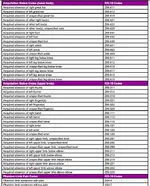Words like proximal, middle, and distal really help but not all surgeons document in that way. These words apply when the long structures of the extremities are being detached. This includes even the very small long structures of the fingers and toes. Think of these structures as being divided into thirds. Anywhere in the proximal third is high, the middle third is mid, and the distal third is low.
ICD-10-PCS Guideline A11 does say that it is the coder’s responsibility to interpret the documentation, but when in doubt, the coder should query.
Interpreting the documentation means looking for clues in the documentation such as “above the medial malleolus.” I interpret this to mean a low amputation. Similarly, “below the tibial tuberosity” to me means a high amputation was performed. A mid-level amputation can be more challenging. Look for documentation that says something about the calf area or mid-shaft for the leg or the middle phalanx for fingers and toes.
A below-knee amputation (BKA) is a transtibial amputation that involves removing the foot, ankle joint, distal tibia, and fibula with related soft tissue structures.
DX Options
Common Abscess Codes:
Common Neoplasm Code Examples:
Common Procedures:
Examples:
CPT 28810 Amputation, metatarsal, including toe, single
Total Ray Resection:
CPT 28810 Amputation, metatarsal, including toe, single
Transmetatarsal:
CPT 28805 Amputation, foot; transmetatarsal
TMA Revision:
CPT 28122 Partial excision (craterization, saucerization, sequestrectomy, or diaphysectomy) bone (eg, osteomyelitis or
bossing); tarsal or metatarsal bone, except talus or calcaneus
CPT 28122 x __ units
Depending on the payer may need to place codes on separate lines
May need 59 modifier
RT/LT modifiers may be appropriate
If inside global be sure to use modifier 58 or 78
Midtarsal:
CPT 28800 Amputation, foot; midtarsal (eg. Chopart typeprocedure) spares the talus and calcaneus
Ankle:
CPT 27889 Ankle disarticulation
Transmalleolar:
CPT 27889 Ankle disarticulation
Other:
Additional Codes:
Modifier 58
Staged or Related Procedure or Service by the Same
Physician During the Postoperative Period:
It may be necessary to indicate that the performance of a procedure or services during
the post operative period was (a) planned or anticipated (staged); (b) more extensive
than original procedure; or ©for the therapy following a surgical procedure. This
circumstance may be reported by adding modifier 58 to the staged or related
procedure.
Note: For treatment of a problem that requires a return to the operating room or
procedure room, see modifier 78
Modifier 78
Unplanned Return to the Operating/Procedure Room by the
Same Physician Following Initial Procedure for a Related
Procedure During the Postoperative Period.
It may be necessary to indicate that another procedure was performed during the
postoperative period of the initial procedure (unplanned procedure following initial
procedure). When this procedure is related to the first and requires the use of an
operating or procedure room, it may be reported by adding modifier78to the related
procedure.
Common Osteomyelitis Codes:
Acute:
M86.071 Acute hematogenous osteomyelitis, right ankle and foot
M86.072 Acute hematogenous osteomyelitis, left ankle and foot
M86.171 Other acute osteomyelitis, right ankle and foot
M86.172 Other acute osteomyelitis, left ankle and foot
Subacute:
M86.271 Subacute osteomyelitis, right ankle and foot
M86.272 Subacute osteomyelitis, left ankle and foot
Chronic:
M86.371 Chronic multifocal osteomyelitis, right ankle and foot
M86.372 Chronic multifocal osteomyeltis left ankle and foot
M86.471 Chronic osteomyelitis with draining sinus, right ankle and foot
M86.472 Chronic osteomyelitis with draining sinus, left ankle and foot
M86.571 Other chronic hematogenous osteomyelitis, right ankle and foot
M86.572 Other chronic hematogenous osteomyelitis, left ankle and foot
M86.671 Other chronic osteomyelitis, right ankle and foot
M86.672 Other chronic osteomyelitis, left ankle and foot

ICD-10-PCS Guideline A11 does say that it is the coder’s responsibility to interpret the documentation, but when in doubt, the coder should query.
Interpreting the documentation means looking for clues in the documentation such as “above the medial malleolus.” I interpret this to mean a low amputation. Similarly, “below the tibial tuberosity” to me means a high amputation was performed. A mid-level amputation can be more challenging. Look for documentation that says something about the calf area or mid-shaft for the leg or the middle phalanx for fingers and toes.
A below-knee amputation (BKA) is a transtibial amputation that involves removing the foot, ankle joint, distal tibia, and fibula with related soft tissue structures.
DX Options
- Abscess
- Cellulitis
- Diabetes
- Gangrene
- Neoplasm
- Osteomyelitis
Common Abscess Codes:
- L02.611 Cutaneous abscess of right foot
- L02.612 Cutaneous abscess of left foot
- L03.115 Cellulitis of right lower limb
- L03.116 Cellulitis of left lower limb
- L03.031 Cellulitis of right toe
- L03.032 Cellulitis of left toe
- E10.52 Type 1 diabetes mellitus with diabetic peripheral angiopathy with gangrene
- E11.52 Type 2 diabetes mellitus with diabetic peripheral angiopathy with gangrene
- A48.0 Gas Gangrene
- I70.261 Atherosclerosis of native arteries of extremities with gangrene, right leg
- I70.262 Atherosclerosis of native arteries of extremities with gangrene, left leg
- I70.263 Atherosclerosis of native arteries of extremities with gangrene, bilateral legs
- I96 Gangrene, not elsewhere classified
Common Neoplasm Code Examples:
- C40.21 Malignant neoplasm of long bones of right lower limb
- C40.22 Malignant neoplasm of long bones of left lower limb
- C43.71 Malignant melanoma of right lower limb, including hip
- C43.72 Malignant melanoma of left lower limb, including hip
Common Procedures:
- Partial bone
- Toe
- MPJ
- Ray
- TMA
Examples:
- CPT 28120 Partial excision (craterization, saucerization, sequestrectomy, or diaphysectomy) bone (eg, osteomyelitis or bossing); talus or calcaneus
- CPT 28122 Partial excision (craterization, saucerization, sequestrectomy, or diaphysectomy) bone (eg, osteomyelitis or bossing); tarsal or metatarsal bone, except talus or calcaneus
- CPT 28124 Partial excision (craterization, saucerization, sequestrectomy, or diaphysectomy) bone (eg, osteomyelitis or bossing); phalanx of toe
- CPT 28825 Amputation, toe; interphalangeal joint
- CPT 28820 Amputation, toe; metatarsophalangeal joint
CPT 28810 Amputation, metatarsal, including toe, single
Total Ray Resection:
CPT 28810 Amputation, metatarsal, including toe, single
Transmetatarsal:
CPT 28805 Amputation, foot; transmetatarsal
TMA Revision:
CPT 28122 Partial excision (craterization, saucerization, sequestrectomy, or diaphysectomy) bone (eg, osteomyelitis or
bossing); tarsal or metatarsal bone, except talus or calcaneus
CPT 28122 x __ units
Depending on the payer may need to place codes on separate lines
May need 59 modifier
RT/LT modifiers may be appropriate
If inside global be sure to use modifier 58 or 78
Midtarsal:
CPT 28800 Amputation, foot; midtarsal (eg. Chopart typeprocedure) spares the talus and calcaneus
Ankle:
CPT 27889 Ankle disarticulation
Transmalleolar:
CPT 27889 Ankle disarticulation
Other:
- CPT 27882 Amputation, leg, through tibia and fibula; open, circular (guillotine)
- CPT 27884 Amputation, leg, through tibia and fibula; secondary closure or scar revision
- CPT 27886 Amputation, leg, through tibia and fibula; reamputation
Additional Codes:
- CPT 20220 Biopsy, bone, trocar, or needle; superficial (eg. Ilium, sternum, spinous process, ribs)
- CPT 14040 Adjacent tissue transfer or rearrangement, forehead, cheeks, chin, mouth, neck, axillae, genitalia, hands, and/or feet; defect 10 sq cm or less
- CPT 14041 Adjacent tissue transfer or rearrangement, forehead, cheeks, chin, mouth, neck, axillae, genitalia, hands and/or feet; defect 10.1 sq cm to 30.0 sq cm
- CPT 27686 Lengthening or shortening of tendon, leg or ankle; multiple tendons (through same incision), each
- CPT 27687 Gastrocnemius recession (eg, Strayer procedure)
Modifier 58
Staged or Related Procedure or Service by the Same
Physician During the Postoperative Period:
It may be necessary to indicate that the performance of a procedure or services during
the post operative period was (a) planned or anticipated (staged); (b) more extensive
than original procedure; or ©for the therapy following a surgical procedure. This
circumstance may be reported by adding modifier 58 to the staged or related
procedure.
Note: For treatment of a problem that requires a return to the operating room or
procedure room, see modifier 78
Modifier 78
Unplanned Return to the Operating/Procedure Room by the
Same Physician Following Initial Procedure for a Related
Procedure During the Postoperative Period.
It may be necessary to indicate that another procedure was performed during the
postoperative period of the initial procedure (unplanned procedure following initial
procedure). When this procedure is related to the first and requires the use of an
operating or procedure room, it may be reported by adding modifier78to the related
procedure.
Common Osteomyelitis Codes:
Acute:
M86.071 Acute hematogenous osteomyelitis, right ankle and foot
M86.072 Acute hematogenous osteomyelitis, left ankle and foot
M86.171 Other acute osteomyelitis, right ankle and foot
M86.172 Other acute osteomyelitis, left ankle and foot
Subacute:
M86.271 Subacute osteomyelitis, right ankle and foot
M86.272 Subacute osteomyelitis, left ankle and foot
Chronic:
M86.371 Chronic multifocal osteomyelitis, right ankle and foot
M86.372 Chronic multifocal osteomyeltis left ankle and foot
M86.471 Chronic osteomyelitis with draining sinus, right ankle and foot
M86.472 Chronic osteomyelitis with draining sinus, left ankle and foot
M86.571 Other chronic hematogenous osteomyelitis, right ankle and foot
M86.572 Other chronic hematogenous osteomyelitis, left ankle and foot
M86.671 Other chronic osteomyelitis, right ankle and foot
M86.672 Other chronic osteomyelitis, left ankle and foot



